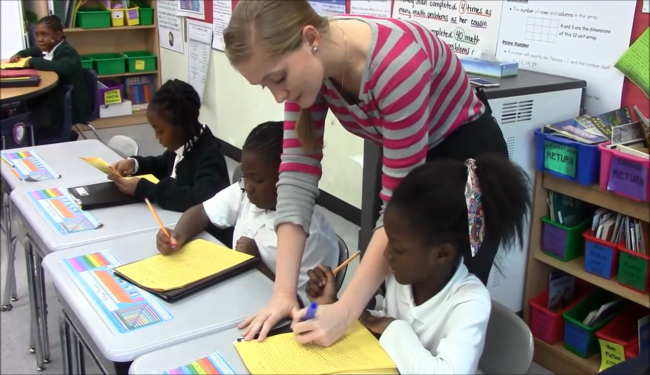03.17.17Video of the Week: Emily Badillo’s Right is Right
 My very favorite video I’ve watched this week is of 4th grade teacher Emily Badillo at Excellence Girls Academy in Brooklyn. It’s about the best example you’re going to see of the Right is Right technique. But it shows a lot more than that. Here’s some play-by-play:
My very favorite video I’ve watched this week is of 4th grade teacher Emily Badillo at Excellence Girls Academy in Brooklyn. It’s about the best example you’re going to see of the Right is Right technique. But it shows a lot more than that. Here’s some play-by-play:
Emily is asking her students about the key facts in an article they read describing American colonists’ reaction to George Washington’s decision to enlist the support of Baron von Steuben in training and professionalizing the Continental Army. She asks, “How did their opinion about Steuben) change by the end?”
My colleagues and I think this is a beautiful example of Right is Right for a couple of reasons. First because of Emily’s dedication to making sure her students answer her question. They’re excited to describe lots of things they know about von Steuben. Trouble is a lot of them are not answers to the question she asked, and she does a really nice job of maintaining their enthusiasm and crediting their knowledge even while clarifying how the question she asked is different from the one they answers:
“My question was how did their opinion change,” she explains when a student just tells her what the colonialists’ opinion was. Then, when another student answers a different question, “You’re jumping ahead to why. I just want to know how. How did their opinion change?” The whole time she’s positive and energetic and as you can see she’s getting dozens of eager hands from her girls. She’s keeping the mojo positive while demanding rigor and intellectual discipline. “Eyes here,” she says at last, to show she really needs them to listen, “When I say ‘how did their opinion change?’ I want to know- it changed from what to what. At first we know they thought he was a traitor that changed to what opinion?
Badillo.Traitor.Recut from Uncommon Schools on Vimeo.
This is a bit of a chronic problem in classrooms… students un-intententionally (or sometimes intentionally) substitute a different question for the one we ask and they answer that. But sometimes it’s important to answer the question- I mean there’s no sense asnking rigorous questions if we don’t then cause students to actually answer them!
Once Emily gets the girls locked in on what her question is asking them to do she holds those standards high, refusing to “round up” and pretend a student has said what she hasn’t–even though her student struggles to make her thoughts clear–helping her girls to learn through experience what a great answer looks like. She’s lovingly relentless and we not only love that but we think it’s a great service to kids.
A couple of other things we note about Emily’s classroom: When a student speaks other students put their hands down; this shows they are listening and attentive. What you say matters and your classmates value it. She’s also clear on how she wants students to participate. Because it’s clear that she wants hands, no one calls out and this allows her to direct the question to exactly the student she most wants to answer it. We also like that she’s reading a rigorous content rich text and asking knowledge-based questions about it.
Great stuff, Emily!
